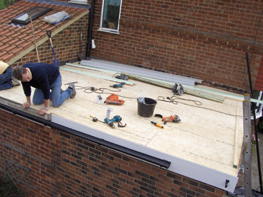Flat Roofing – which material is best for you and your home?
Flat Roofing – which material is best for you and your home?
When it comes to choosing the best kind of material for your flat roof, the options can seem a little daunting. Flat roofing materials have drastically improved over the years, making it harder to know which is right for you and your home, and with this sort of decision, a little knowledge goes a long way. Of course, the key is to ensure the roof stays dry and cool, so the material you pick must allow water to run off easily as well as be as reflective as possible. This quick run-through of various flat roofing materials should give you an insight into the options available to you.
If you are looking for a built-up roof (BUR) then the standard hot tar and gravel may be your best bet. The layering involved in the application help with regards to preventing dampness and leaks – the tar is applied in layers with gravel on the top of the roof. Gravel gives the flat roof a great-looking finish;, however, the application process can be messy. Tar and gravel are also very heavy, so you must ensure that your house is structurally secure before going ahead. If a tar and gravel BUR isn’t for you then perhaps rubber may be the solution you are looking for. Although prices will of course vary depending on where you are and who you ask, rubber (EDPM is usually used) does tend to be the more expensive option, this is because it is very durable and also a lot lighter than the tar and gravel alternative.
If neither rubber nor tar and gravel is right for you, bitumen is another material to consider. Bitumen, like rubber, falls under the category of single-ply roofing – so it would also be a lot lighter than tar and gravel BUR. There are various ways bitumen can be applied; you can heat the material as you roll it onto your flat roof, or go for a ‘stick then peel’ version. This makes it a lot easier for home installation, although the aid of a professional roofer would of course always be recommended. Bitumen tends to be less tear-resistant compared t other flat roofing materials, which is something else to take into consideration.
Asphalt or PVC are two further options that have been tried and tested. There are a few different types of asphalt that can be used for flat roofing, and it can be used to create a BUR. But be warned; despite the fact that asphalt takes a long time to be affected by water, during installation the gases which are produced can be harmful to the environment. PVC is another single-ply roofing material and although it can be pricey, is it incredibly strong and forms a watertight seal.
As you can see, when it comes to the different materials on offer for flat roofing, there are plenty of options. After your budget, think about the structure of your house and the ease of installation when considering your options. Any professional roofer will be able to recommend which material they think is best for your flat roof as well as make the installation as quick and easy as possible.

